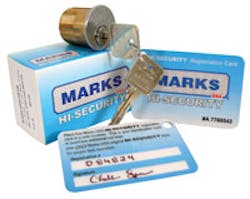Marks USA was established in 1977 by its founder and president, George Marks. Known for quality and dependability, Marks locks carry a lifetime warranty. Marks USA is recognized as a leader in introducing new products such as their 195 series Grade 1 lever lock.
It is a short step from offering quality locksets with traditional cylinders to upgrading Marks locks with the availability of a more secure lock cylinder system. Marks USA Hi-Security cylinders provide key control by deterring unauthorized key duplication (photo 1). The Hi-Security cylinders also provide protection against key bumping, drilling and picking attacks. The public is now being made more aware of possible weaknesses in traditional cylinders. Marks USA has the perfect answer at just the right time.
Marks USA hi-security has been assigned multiple international and U.S. patents which will provide key control protection for years to come.
HOW IT WORKS
Marks USA HI-Security cylinders have a dual locking system. First, most cylinders have the traditional six-pin locking system. Depths and spaces are identical to those used for SC1 Schlage keyways, so key origination can be done by using Schlage dimensions. Master keying jobs can be accomplished by using the same two-step rules as for Schlage. Key duplication or keys cut by depth and spaces can be done using standard key cutting equipment.
A second locking system is operated by a wave pattern milled into the side of the blank (photo 2). The wave pattern is referred to by Marks USA as a ‘security code’. Security pins interact with the wave pattern as the key is inserted into the lock. Security pins have four different depths. With four depths and five security pins in most locks, there is a possible 1024 individual wave patterns or security codes, although only approximately 900 are planned for use. Marks USA also has several different key grooves, so the amount of possible individual ‘keyways’ is quite large.
Photo 3 shows the sidebar elements. If the wave pattern is correct for that lock cylinder, notches in the security pins will be held in a straight line. The ‘V’ shaped, hardened locking side bar is then moved into the aligned notches as turning pressure is exerted on the key. If either the key cuts or wave pattern is incorrect, the plug will not turn.
Key blank wave milling and installation of the security pins is completed at the Marks factory. In a keying alike or masterkeying situation, locksmiths will only have to pin the plug using traditional pins from a standard pin kit of their choice. If you are familiar with the sidebar locking system proven for over 50 years on GM vehicles, then you already have some idea about how the security pins and sidebar interact in the Marks USA Hi-Security system.
Marks Hi-Security cylinders will initially be available as mortise/rim (photo 4), key-in-knob (photo 5), Small format interchangeable core (SFIC) (photo 6) and large format interchangeable core to replace Schlage. 1 1/8” mortise cylinders are drilled and tapped to accept rim cylinder screws. Packaging contains all parts to quickly convert the cylinder for mortise or rim usage. Optional cylinders with protective hardened material installed are available to meet UL437 anti-drilling requirements. Mortise cylinders are available in lengths from 1” to 1 3/4”.
Spacing and depths for the SFIC cylinders use the same keying dimensions as other A2 systems. Marks SFIC cylinders are available in six pin or seven pin lengths. Standard SFIC pinning kits can be used to combinate Marks USA Hi-Security locks.
One notable difference with Marks Hi-Security SFIC cylinders concerns the rods which connect the cylinder tailpiece to the lock cylinder. The left rod must be shortened because the locking sidebar occupies some of the space used by a normal length rod. Marks sells a special tool for this job. A twist of the wrist removes the correct rod portion. Four security pins are used in the SFIC cylinders in order to make space for the shortened rod. Present SFIC cylinders have individual screw retainers to cap the pins and springs. Plans call for a later version which will use press-in capping discs.
Marks Hi-Security Schlage replacement IC cores use standard SC1 depths, spaces and pinning. The Schlage system uses a seven pin control key blank. Locksmiths will usually cut the control key to the master key cuts for the first six spaces and then add the proper depth cut in the seventh position to operate the retainer pin.
GETTING STARTED
Marks USA has two different programs for locksmiths. The first program allows Marks locksmith distributors to have one security code which is available to all locksmiths. There is no minimum buy-in. Locksmiths can purchase key blanks, plus zero-bitted or keyed lock cylinders. There is no paperwork involved. Individual locksmiths keep their own records of end-user names and addresses, master key system coding or any other customer information.
The second program grants a geographically exclusive security code to a dealer/locksmith. Locksmiths on the second program must purchase 20 cylinders, at least 100 five-pin or 100 six-pin key blanks, a key stamping die and a parts service kit. Locksmiths must choose one individual locksmith distributor to purchase from and that distributor agrees to keep an inventory of Marks Hi-Security key blanks in stock for each locksmith on the program.
Marks USA has developed one of the easiest-to-use Hi-Security packages available today. They have a patented system with low initial investment and minimal paperwork requirements to join the program. The lock system can be easily serviced on-site or in shop; all this from a reliable lock company such as Marks USA.
For further information contact your local Marks locksmith distributor or contact Marks USA at: 631-225-5400, www.marksusa.com.






